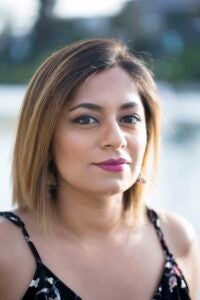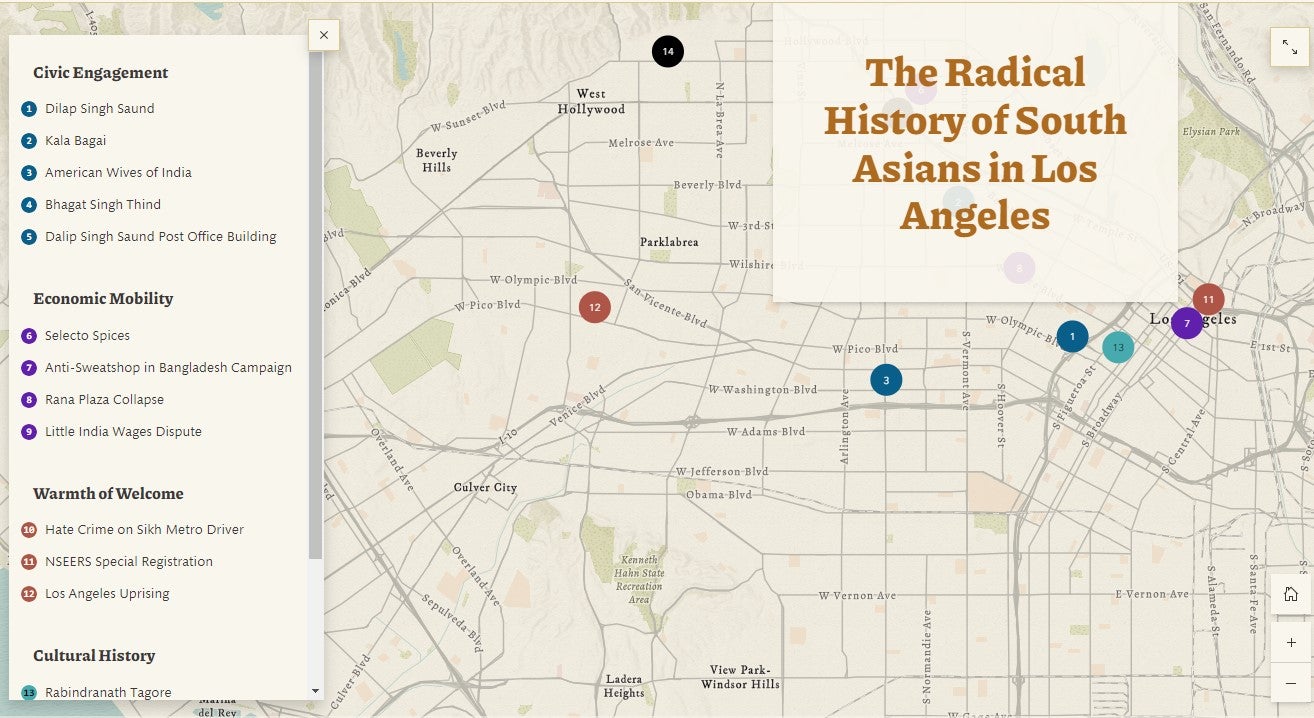
The Radical History of South Asians in Los Angeles Map
Did you know that the overthrowing of the British Empire out of India has deep roots in Southern California? Or that the first South Asian Congressperson represented the Imperial Valley and lived in Pasadena? Or that the outdoor Indian jungle scene of the 1942 version of Jungle Book was filmed by a lake in Ventura? Or that a string of Indian restaurants in West Pico were burned to the ground during the 1992 Los Angeles Uprisings?
I sure didn’t. I was born and raised in Los Angeles to immigrant Bangladeshi parents who moved to L.A. in the first wave of migration post-1965 Immigration Act. This act led to an influx of South Asians allowed to move to the US – a change from the previous immigration regulations where only a hundred immigrants per nation were allowed in the country. My dad came to Los Angeles in 1969, along with a group of other young Bengali men from his village. They landed not too far from what is now Little Bangladesh, in a house full of Bengali men sleeping in shifts between working service jobs and attending classes. After an arranged marriage a decade later, my mom came to Los Angeles, and here my parents made their home for fifty years.
I loved Los Angeles and I love Los Angeles, in a way that only someone born and raised here can. It’s a city of contradictions and a city of nomads. I loved the communities I was raised in and alongside, the eclectic range of imaginations, and the Santa Ana winds. I tried moving away several times, but I kept getting pulled back. As a South Asian American in Los Angeles, I grew up feeling like an outsider – never seeing my left-leaning politics driven by my lived experiences in a Brown female body reflected in the mainstream media around me. But it was just a façade – there were so many people in Los Angeles like me, our stories were just marginalized.
The reality is that Los Angeles County is home to one of the largest populations of South Asians in the country, with over 150,000 people with heritage from India, Bangladesh, Pakistan, Sri Lanka, and Nepal. In the surrounding counties of Southern California, close to half a million South Asian live in the region, and growing at a rapid pace. The region is home to a Little India, a Little Bangladesh, and the city of Lancaster is even dubbed Sri Lanka-ster for its Sri Lankan population.
As my activism work bloomed, I started to dig into the radical history of the Asian American movement. I was inspired by learning about Bay Area activist Yuri Kochiyama and the efforts of Japanese youth in the 1970s to memorialize the Manzanar Internment camp so history wasn’t forgotten. As someone who was working intimately with the civic engagement of South Asians across the country, I was curious about where South Asian American activism history existed. I wanted proof that I came from a community that was making inspirational differences here in California, too.
As I started to dig into the archives, I researched and collaborated with other South Asian American archivists such as the South Asian American Digital Archives, the folks at Berkeley South Asian Radical History Walking Tour, and Vivek Bald who produced the documentary Bengali Harlem. I learned about the Ghadar Party, which was a radical Berkeley-based movement started in 1912 to overthrow the British government out of India. I learned that the first South Asian American Congressman came out of representing Southern California in the 1950s, and that his campaign to give South Asians the right to vote started in an office building where Regal Live is now. I learned that the first filmmakers in the multi-billion dollar Bollywood movie industry got their education in the film industry of Los Angeles. I learned that every time there wasa racial uprising in California, chances were there was a South Asian American in the background also marching in solidarity.
This is what pushed me to create the Los Angeles South Asian American Radical History Map. The hope is for the map to serve to document just those moments of time. This pilot project will take interested amateur historians through a journey across Los Angeles and through time, across different moments that have created a legacy of South Asian American local history. As a pilot project, this map currently tracks fifteen places of significant moments – with the hope being that the map will evolve into a 100+ locations documenting and telling the audio narrative of the various radical moments in Southern California. The final project will be an interactive map where you will be able to listen to the narratives of each location while on a driving tour.
The narrative currently includes:
The Ghadar Party:
The Ghadar Party was a revolutionary movement founded in California by Punjabi laborers and Bengali intellectuals to overthrow the British colonization forces in India. Founded in 1912, the party had chapters all across the West Coast, with the main hub in San Francisco. Members would communicate with each other through a weekly newsletter that would be mailed out globally. Here in Los Angeles in 1915, Ghadarites stocked the SS Maverick with arms and propaganda materials at the San Pedro Port before sending it to India in a failed attempt to overthrow the British (in what is known as the Hindu German Conspiracy.) Local Ghadar Party member and noted woman Kala Bagai moved to Los Angeles’ Koreatown in the 1940s, where she became known as Mother India for her ability to bring the community together.
Civic Engagement:
Two other notable South Asian American figures also made their home in Southern California. Soon after landing in America, a Punjabi man named Bhagat Singh Thind was recruited to fight in the U.S. Army for World War I.e was granted U.S. citizenship in 1918 while serving in the U.S. military, but the Bureau of Naturalization quickly revoked it because he was a “Hindoo”. The case went up to the Supreme Court where Thind argued that Indians were White and deserving of citizenship and the judge ruled they weren’t “by the common definition of White.” This landmark case would take decades to be reversed. Dalip Singh Saund, a Punjabi mathematician, moved to the Imperial Valley after college to work on the cabbage farms. He became a prominent Toastmaster and involved in local politics, eventually founding the India Association of America in 1942. The organization would be instrumental in passing the Luce-Celler Act, which gave citizenship to all South Asian Americans. His political involvement would lead him to be elected as the first Asian American in Congress.
Resistance:
The growing South Asian American population in Southern California went hand in hand with a growing xenophobic sentiment laced throughout the region. During the Los Angeles Uprising of 1992, spurred by the Rodney King beating verdict, hundreds of Korean businesses were targeted due to racial tensions. A block of Indian stores in the Pico Robertson area were also targeted, with four of them burned down. Los Angeles has also been a place where South Asians have unfairly been targeted in unprovoked hate crimes across the region, fromattacks on turban-wearing bus drivers to biased treatment by cops. With each of these moments, we see an emerging narrative of resistance as well. The community organized to voice these issues, starting all kinds of organizations and efforts over the years. Little India in Artesia has been home to many organizing efforts – from solidarity protests to voter registration drives to fighting for exploited workers. In 2011, South Asian Network was instrumental in getting 22 employees of a local South Asian eatery $95,000 in back wages and they have been involved.
These are just a few of the South Asian American narratives weaved into the soul of Los Angeles, and there are so many more still yet to be discovered for this map. These fifteen moments are only the start of what will become a much fuller and interactive map that will be accessible while going on driving tours across Southern California. The history goes much further and deeper than I ever could have known.
After 9/11, when I began my career encouraging South Asian Americans to vote and build political power in America as South Asians and Muslims, I realized that our community would only get civically engaged if I could convince them that our contributions were important to the foundation and fabric beyond the American dream. Uniting to defend ourselves against post-9/11 backlash would only take us so far. Learning and sharing the history of South Asian American history helped people feel rooted and that their citizenship here was building on a legacy of civic engagement. We have a South Asian American Vice President now because of the campaign that Dalip Singh Saund that led to South Asians gaining the right to vote. Being able to share about the Bellingham Race Riots of 1907 and that South Asian businesses were burned in the 1992 Los Angeles Uprising made it easier to organize the community around Black Lives Matter in 2020. Teaching people about the 1912 Ghadar Party’s effort to decolonize India from the British Empire empowers this generation of South Asians Americans to fight for social justice now.
Knowing that I have history as a South Asian American and a Muslim woman in the city where I was born makes me feel grounded. May this map serve to ground your existence in a Radical South Asian American narrative, as well.
© 2024. This work is licensed under a CC BY-NC-ND 4.0 license.
 About the author:
About the author:
Tanzila (Taz) Ahmed is one of USC ERI’s 2023 Turpanjian Scholars-in-Residence. Taz is a political strategist, storyteller, and artist. Check out her full bio at: https://www.tazzystar.me/bio.
